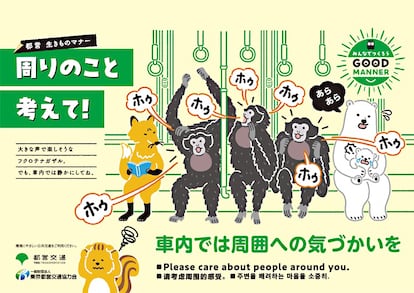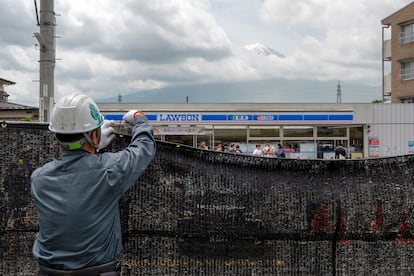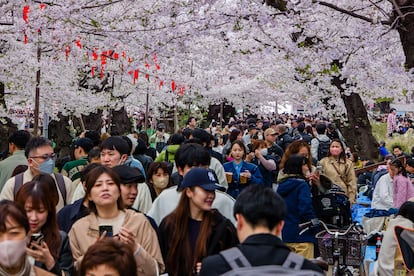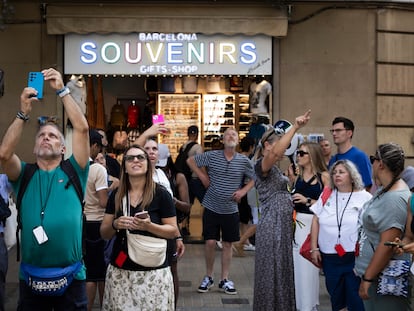Good manners become collateral victims of mass tourism in Japan
New visitors are often uninterested in the cultural aspects of the country, and show no inclination to observe its rules of etiquette. Overcrowding is also a problem on public transportation and at landmark sites

Extreme courtesy and good behavior in public spaces have become collateral victims of mass tourism in Japan, an increasingly popular destination as the yen depreciates. But the vast majority of these new visitors are more interested in shopping than in culture. “Lately, there are more visitors who arrive blindly, without any prior knowledge of the culture,” laments Enrique Medina, a Madrid-based photographer and tour guide who accompanies groups from Spain and Latin America around the country.
Until recently, foreign tourists usually did some research before going to Japan, he notes, citing as an example those who go in April to see the cherry blossoms, an eagerly awaited annual event that covers parks and avenues throughout the archipelago in pale pink. But the current tourist motto seems to be “fewer temples and more shopping; less sushi and more fast food,” adds Medina, citing the devaluation of the yen, which this year has hit historic lows against the euro and the dollar.
Tour guides are at pains to explain to their clients the civic norms of a country that was closed to the world for more than 200 years (between the 17th and 19th centuries), and whose daily exchanges are governed by an intricate etiquette that is too rigorous for Western standards. Tourists listen in wonderment to the descriptions that guides like Medina make of the behavior of passengers on the Tokyo subway. Commuters wait on the platforms in orderly and silent lines to speed up the boarding and disembarking of passengers and to avoid the slightest delay in departure. Outside of rush hour, the carriages are usually calm places and the rule of not talking on the mobile phone is strictly adhered to. But when tourists get on, they invade the space with their shouts and gesturing. Many Japanese passengers get annoyed, but, having been educated to avoid confrontation, they simply choose to change carriages.
The scene is recurrent on central subway routes, and transit companies are conducting awareness campaigns with posters. One sign put up by the company Toei Transportation shows three monkeys shouting inside a carriage while next to them a fox tries to read, a polar bear comforts her frightened cub and a squirrel indignantly puts its hands on its head. “Please care about people around you” reads the phrase on the poster, which has been translated into English, as well as Chinese and Korean, the two main nationalities of tourists in the country. The illustration is a reference to the Three Wise Monkeys, a popular pictorial maxim that shows an ape covering its eyes, another covering its mouth and the last covering its ears and which, according to tradition, means “see no evil, hear no evil, speak no evil.” The campaign has the purpose of “offering comfort to passengers and creating harmony,” according to a spokesperson for Toei Transportation.

A survey by the consultancy EY Japan revealed that the three worst consequences of mass tourism are poor manners, as well as overcrowding on public transportation and in neighborhoods with tourist attractions.
Due to its small size and numerous traditional attractions, Kyoto is one of the cities that is suffering the most from the impetus of mass tourism. In the traditional district of Gion, hordes of tourists armed with cameras and mobile phones are besieging the geishas and their apprentices, called maiko, with such insistence that the local media have coined the nickname “geisha-paparazzi.” The local government closed some entrances to Gion to the public, put up No Photos signs and began imposing fines of €60 for violators.
The most widely publicized measure to tackle the excesses of tourism was the installation last May of a huge black tarp to prevent people from photographing Mount Fuji in the town of Fujikawaguchiko, west of Tokyo. The aim was to discourage visitors who were climbing onto the roofs of houses or interrupting traffic to get a viral photo of a Lawson’s chain store crowned by the iconic volcano. At the end of August, following a typhoon warning, the tarp was taken down and the mayor of Fujikawaguchiko told the local media that it will not be put up again, as foreign tourists “have realized that such measures are unnecessary if good manners are observed.” Some media reported, however, that tourists had discovered another store in the area where a similar image can be obtained.

A recent study published by The Japan Times indicates that the Asian country received 25 million international travelers in 2023, a rate of 0.2 tourists per capita, which is considered low compared to France and Spain, which receive 1.5 and 1.8 tourists per capita, respectively. Japan aims to receive 60 million visitors by the end of the decade, which would raise the number of visitors to approximately 0.5 per capita, a figure that, according to the same study, is still low by European standards.
For Teruo Nakanishi, a taxi driver in his sixties working in Kyoto, mass tourism affects only the central districts and has revitalized his city’s economy. “Many hotels and guest houses have sprung up, even on streets where it is very difficult to drive,” he says, referring to the ancient layout of the city, which was spared from the American bombings of World War II because of its great cultural heritage. He is grateful that taxi companies in Kyoto are advertising vacancies for people up to 64 years of age due to a shortage of labor, aggravated by population aging.

Another consequence that is beginning to emerge is the gradual acceptance by Japanese society of foreign immigration, as many hotels and businesses in Kyoto and other cities depend on Filipino and Vietnamese personnel for their catering and cleaning services.
Sign up for our weekly newsletter to get more English-language news coverage from EL PAÍS USA Edition
Tu suscripción se está usando en otro dispositivo
¿Quieres añadir otro usuario a tu suscripción?
Si continúas leyendo en este dispositivo, no se podrá leer en el otro.
FlechaTu suscripción se está usando en otro dispositivo y solo puedes acceder a EL PAÍS desde un dispositivo a la vez.
Si quieres compartir tu cuenta, cambia tu suscripción a la modalidad Premium, así podrás añadir otro usuario. Cada uno accederá con su propia cuenta de email, lo que os permitirá personalizar vuestra experiencia en EL PAÍS.
¿Tienes una suscripción de empresa? Accede aquí para contratar más cuentas.
En el caso de no saber quién está usando tu cuenta, te recomendamos cambiar tu contraseña aquí.
Si decides continuar compartiendo tu cuenta, este mensaje se mostrará en tu dispositivo y en el de la otra persona que está usando tu cuenta de forma indefinida, afectando a tu experiencia de lectura. Puedes consultar aquí los términos y condiciones de la suscripción digital.











































